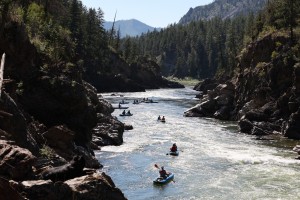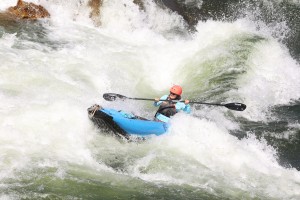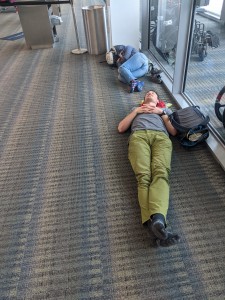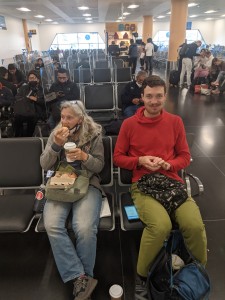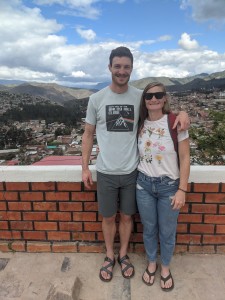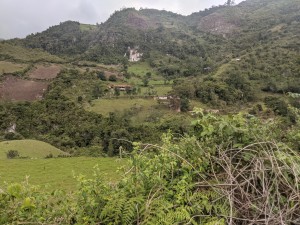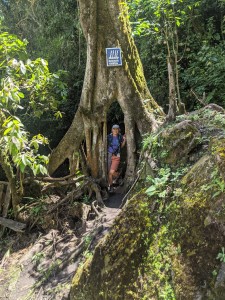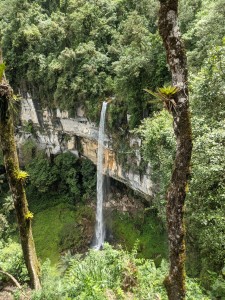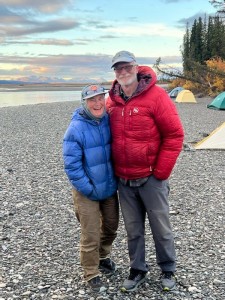CHAPTER 12: APRIL – HOMECOMING
Hunkering. That’s what it feels like. Hunkered in, staying solitary, watching the human world flounder. And it isn’t pretty.
No socializing, no going out to eat, no movies, no gym workouts, no school, no yoga. Everything is virtual. The world runs on Zoom meetings. Marypat does virtual workouts in the driveway with the kids, all distanced from each other on their yoga mats, following coaches on a computer screen. We sit with family and close friends only outside and at a distance. If we plan a hike with friends, everyone drives their own car to the trailhead, keeps well spaced on the walk.
We mask up to go in stores, step back if someone gets too close, give each other a wide berth on the sidewalk. Hand sanitizer is suddenly everywhere, every office, every store, every car, every bathroom. When you sign a receipt there’s a bin for clean pens and one for used. The world has a new measurement – six feet, reinforced by marks on the floors, arrows, signs. Mostly we all cloister with our immediate family, or alone.
Stimulus checks arrive. A temporary lifeline for those millions who can’t make rent or haven’t received unemployment checks. Bike stores can’t keep bicycles in stock. RVs are in high demand. Trailheads and fishing access sites are suddenly clogged with people with no job to go to, no travel possible, uncertain finances, nothing to do but get outside. Weddings and funerals and graduations are called off, postponed, or done through computer screens.
Protocol judgment calls confront us many times every day. Go to the grocery store or not. Hug the kids? Even see the kids? Touch the handle of the shopping cart? Leave the store where people aren’t wearing masks? Refuse to see the friend who doesn’t take Covid seriously? Plan ahead?
For me, it’s impossible to be rigidly consistent. How can you not hug your kid? What do you do when one of the little kids at a family gathering runs up to you and throws themselves into your arms? If you start thinking about all the vectors of possible contacts, you drive yourself crazy. Ruby’s roommate who is in a band, the friend who recently traveled, Sawyer’s roommate’s girlfriend who recently tested positive and is quarantined at her parent’s house, all the people you brush past in the grocery aisle, that person who coughed in the post office line . . . endless. I start envisioning viral clouds emanating everywhere, like fogs of breath on a winter day, potential evil vapors steaming from all of us. Total crapshoot.
Inevitably, I am sucked back into the obsessive news habit. What else is there to do? Hours a day trolling through talking heads, podcasts, late night comedy shows, editorial pages. Ironically, some of the most on-target coverage is delivered by comics. And it is morbidly rewarding, sickeningly entertaining. Here’s our president suggesting that we might ingest bleach, or shoot up with ultra-violet sunlight. “It’s worth a try, right?” he asks his medical team at a press conference. “I mean, it seems like something to look into, doesn’t it?” And these professionals have to sit there and nod like he’s sane. Yeah sure, Mr. President, why don’t you go first?
Meantime, people die by the tens of thousands. Not one word of consolation from the administration. Only more denial and fantasy and blame and claims of being the best. More people die than died in the Vietnam War, then double that a few weeks later, the curve spiking up like a hockey stick. It is no longer just New York and Seattle. It’s everywhere. And disinformation mingles with real information like sewage spilling into a river, where it becomes indistinguishable. Young people are immune . . . It’s only as bad as the flu . . . The side effects are horrific and last for months or years . . . You are immune once you get it . . . No, there are cases of people being re-infected . . . Masks are good . . . No, masks are worthless . . . Masks actually make you sicker . . . If you wear a mask you’re a commie elitist . . . If you don’t wear a mask you’re a patriot.
The president targets democratic politicians, tweets “Liberate Michigan!” Right on cue a bunch of self-appointed vigilante ‘keepers of the peace’ show up at the statehouse with automatic weaponry and glower over legislators at work. Meantime black men and women are killed routinely by police every couple of days, while a 17-year-old ‘patriot’ with a big gun kills protestors in Wisconsin and the president says it was self defense. Black Lives Matter protests sprout up across the country. Right wing agitators wave Trump flags and brandish lethal weaponry in response. Somehow election campaigns trudge on, almost off stage, and tribal polarization reaches such a fever pitch that talk of civil war is taken seriously.
Our house sale is on pause. Our realtor understands, although she thinks there are buyers bunching up on the border just waiting to gobble up property. “We have had people get in their car, drive here and demand to see houses,” she tells us. “It’s crazy. We are selling houses, sight unseen, via virtual tours.” Maybe so, but becoming homeless is daunting. Travel is out of the question. We haven’t found a new spot to land. The chance to put it off is seductive. Days pass. Things get crazier and crazier. I fall deeper and deeper into the well.
It is Jeff King who hauls me out.
“I just got back from rescuing my rig!” he tells me over the phone.
“You did what?”
“Yeah, I had my van in storage down in Las Vegas and I was getting a little desperate to bring it back home. I decided to rent a car and go down there. It was incredibly reasonable. I told them I wanted a car that hadn’t been used in at least three days. I packed food in a cooler, wore gloves when I pumped gas, never went in a store. I even got so I calculated wind direction when I pulled in for gas and always went to a pump upwind. I stopped on the side of the road to pee, never went inside a rest area, ate food out of the cooler, took naps in the car. Then I got the van and was on my own, self contained. No one is out there on the highways. Definitely a twilight zone, but pretty easy.”
Huh, I think. Sort of brilliant.
Not a week later, Marypat and I do the same thing.
We rent a car, wipe it down, stock up on food and gloves and sanitizer, drive out of town as it starts to snow. South of Billings the snow quits. The highway is eerily empty. I get flashes of apocalyptic movies – deserted, wind-swept relics of civilization with a few humans staggering through the wasteland. Semi trucks and the occasional car, long gaps between. We speed along at 80, develop a system for gloving up and sanitizing every time we pump gas, snack on our food, scan the radio dial, drive right through the night and into Denver in the wee hours. Yes, it’s late, but the streets are devoid of traffic like we’ve never seen them. Where we differ from Jeff’s plan is in our decision to stay with Marypat’s sister, Sally, who we have recently been around at Pat’s bedside, and who has tested negative for Covid. Not a sure thing, but as close as we’re going to get.
After the marathon all-nighter we pause for a day, enjoy each other’s company, get the dogs out for walks, watch some of Sally’s favorite Netflix shows. The next morning we are on the deserted roadways well before dawn, heading south for New Mexico. Along the way we synchronize watches with Kris and Rolf, who have agreed to bring our car to the airport rental drop off. I half expect a checkpoint at the border, but we rise over Raton Pass without incident. We meet around mid-day, wave at each other, follow them to their house, and hitch up the trailer. They leave a bag of their favorite breakfast burritos on the seat to fuel our return, and we wave at them from twenty feet as we pull away, heading back north at the trailer-hauling pace.
The weather deteriorates south of Colorado Springs, and the final two hours back to Sally’s are a white-knuckle nerve test with the trailer fishtailing behind, but we finally regain our refuge just at dark, and regroup for another rest day before heading home. By then the snow has melted off and we relax, driving north through Wyoming, buying gas at less than $1.50 a gallon, back to Montana, back to our driveway where we park the T@B in its assigned spot and breathe deep with satisfaction. One box checked. More important, a dose of normalcy, even a rejuvenating bit of outlaw escape from the clutches of this strange and demoralizing plague.
April’s river remains. Weeks pass. Out of old habit, I start checking the river gauges around the state to monitor spring runoff. It is strangely transporting, even thrilling, to watch the virtual records of flows. Along dozens of waterways in every state, the USGS has set up riverside gauging stations, each run by a small solar panel, which monitor the flow, upload information via satellite, and make available a real-time system of read-outs for anyone to study. I study them daily, especially in the spring.
Through this techie virtual portal I glimpse the magic of seasons turning, of ice melting, snow-pack dwindling, spring storms dumping moisture, and what that does to rivers around the state and around the country. I watch the Salmon and the Snake in Idaho, the Owyhee and Grande Ronde in Oregon, the Rio Grande in Texas. Close to home, I have on my daily radar the Yellowstone, the Missouri, the East Gallatin, the Boulder, the Shields, the Jefferson, the St. Regis, the Clarks Fork – all of them responding to warmth, to rain, to melting snows, to drought.
I have my favorites that I check every time, sometimes several times a day. I notice the lag between high country snowmelt on a warm day and the rise downstream of a river like the Boulder or East Gallatin hours later, when the graph peaks in the middle of the night. After a spring rain, and the resulting rise, I imagine the muddy flows, the moving log jams, the breaking ice floes, the flooding torrents filling banks, and beyond the banks, spreading over flood plains in events both life-giving and destructive. I imagine dangerous battering rams of dead trees cruising down a river that, most of the year, you can walk across without getting your pants wet. I imagine the sound of roiling water, the spring winds, the rustling new leaves on aspen and cottonwood trees, the smell of dirt in the air, and it stirs the paddler in me who wants to participate in the exuberant spring rise, the schussing ride, the mad descent out of the high country, driven by nothing more than volume and gravity and slope. I am like a skier waiting for that powder day on the hill, imagining ‘face shots’ and gullies brimming with drifts and sparkling aprons of new snow.
It is April, so rivers are coming up. The small tributary streams like the East Gallatin rise first and most dramatically. The main stem rivers, the Yellowstone, the Missouri, the Clark Fork, are more ponderous, slower to respond, less dramatic. Their time comes later, in May and June and July, when the wild roses bloom and rivers build to their behemoth, exhilarating, terrifying peaks.
I notice the Big Hole.
The Big Hole flows out of the high country of the Bitterroot Range, into a broad valley that was once home to the Nez Perce, and now to ranchers and small communities like Wisdom and Jackson and Wise River. It meanders quickly through pasture and ranch country, down into forested slopes and canyons, watering one of the most popular fishing destinations in a state famous for fishing locations, where Arctic grayling still eke out an existence in spite of us and where, on a summer day, drift boats punctuate the flow like outsized water bugs with monofilament flailing the air like mobile antennae.
The Big Hole is coming up dramatically.
I remember a solo trip I took many years earlier, when the kids were tiny, paddling the entire Jefferson River from the town of Twin Bridges to the headwaters of the Missouri, known as Three Forks, where the Gallatin, Madison and Jefferson rivers coalesce and make the Mighty Mo. I did it at flood stage and I had to hold myself back to spend two nights on the water. It flushed me down almost 90 miles like my canoe was another piece of flotsam, at a spooky, exhilarating speed that felt like a carnival ride. One of those rides on which you have to remember to breathe.
The Big Hole joins the Beaverhead River near Twin Bridges to form the source of the Jefferson. Down below, summer irrigation dewaters the Jefferson after spring runoff, making it a less than desirable float. Later in the season, the Jefferson ebbs to an anemic, turgid flow susceptible to brutal headwinds. But at high water, early in the year, when birds are flooding north and the current is booming, then it can be a sweet ride indeed. So I watch the Big Hole boosting up, pushing the gauges on the Jefferson. I imagine that river, what it would feel like under my boat hull, and I talk to my partner.
“What do you think of a top-to-bottom float of the Jefferson?” I ask her. I know there’s a chance I can seduce her onto the trip. Her duties as an art teacher at the nearby elementary school are mostly on hold and fluid, given the school shut-down situation. Marypat is nothing if not competitive, and she’s had the Jefferson on her list ever since I did my solo rampage down it and left her behind with the kids.
It is hardly an effort. She signs on with only a whiff of hesitation. “Let’s take Beans,” she says. “Why not?”
There are layers of attraction to the Jefferson. Given the state of the world, it is a safe outing. Just the two of us in one boat, our faithful tandem canoe of 30 years. The logistics are dead easy. Sawyer agrees to drop us off and then leave our vehicle at the take-out. It is close to home, less than two hours from our driveway to the put-in. It grants the delicious satisfaction of running a flow from its source to its mouth, a lure that I have always found irresistible. This time of year, with the water high and muddy, we should have it to ourselves.
“Let’s take our time,” I suggest. “Last time I could have done it in two days, easy. The water is up, but it’s not flood-stage.”
“Okay, how about five days?” Marypat says. “The car will be waiting for us. We could take an extra day or come out a day early and it wouldn’t matter. And we’ll have cell service off and on if we need to let the kids know.”
The chance to leave everything behind – the virus, the insane, tribal politics, the family grieving, the house sale, the uncertain horizon, is undeniable. We mine the freezer for old packets of dehydrated meals, make a shopping list, engage the same old packing routine we’ve repeated over 40 years of gearing up for trips together. It doesn’t take long. This is an easy one.
The day before we leave I chat with an old friend, Jake. He was the one who recommended the realtor we signed up with, and has sold a few houses in his day. I tell him that our plans are on hold for selling the house, that with the uncertainties of the world, we just aren’t sure how we should play things. “We’re thinking of putting it off until fall,” I tell him.
“Boy, I don’t know,” he says. “Who knows what’s going to be going on in the fall. The way they are talking, the virus could be much worse by then. What with the election, the economy, the virus, I think it’s pretty sketchy. If I were you, and things look good for selling this spring, I’d go for it.”
“Hey, you can always park your trailer in my driveway if you’re homeless,” he laughs.
His advice has the ring of truth. Who knows what could be going on by fall? The forecasts are ominous. We’ve come this far down the trail to prepare the house. It does seem like the demand is high. How much of our reluctance is simply resisting the final, arduous push to get it over the finish line? And my guiding principle in life has always been to embrace these leaps of faith that, more often than not, lead to good things. Haven’t I always seen the unknown as an opening to adventure, even if things don’t go according to plan? If nothing else, they make for good stories.
When I mention it to Marypat, she nods, takes a deep breath. “Yeah, we’ve come this far. Maybe he’s right.”
That night we call our realtor to chat. “Listen,” I say. “I think we’re ready. We can pick the exact time, and we’re going on a river trip this week, but I wanted to give you a heads up. We think it’s a go.”
Late morning, April 24th, Sawyer follows us out of our driveway, our boat perched on the rack, supplies filling the back, Beans on his bed, happy to be going wherever we’re going. We drive to Headwaters State Park and leave Sawyer’s car at the take-out on the Missouri, just downstream of the confluence of the three rivers.
It is a powerful geography. Indigenous people understood its significance. Lewis and Clark spent days here, gathering themselves late in the summer of 1805. They faced yet another fork in the road, a decision about which waterway would lead most efficiently to the west coast. They had faced the same choices at the forks of the Missouri and Yellowstone, at the confluence with the Marias. At each, they wandered the countryside in search of clues, talked to natives, studied the landforms. Agonized.
Here, Sacajawea was home. Still a teenager, she had been captured very near this spot by raiding tribes as a young girl, enslaved, brought far down the Missouri to Mandan country, where she had been traded as a bride to a fur-trader, and where, by twist of fate, she had met and been engaged by this foreign troop of strangers who aspired to travel across the continent and who saw her as a potential asset – both as a guide and as a translator. Never mind that she happened to be pregnant, and that she was saddled with her fur-trading lout of a husband. This great coming together of watersheds was her home ground, the landscape where she spent much of her childhood.
I have always thought of the Three Forks as a gigantic palm of geography, with the rivers as the strong lifelines etching the landscape. Named, of course, by Lewis and Clark for politicians. The Madison flowing out of the high plateau of what would eventually become Yellowstone National Park. The Gallatin, named for the Secretary of the Treasury in Jefferson’s administration, unfurling from the high peaks of the Gallatin Range and the fringes of Yellowstone. And the Jefferson, the farthest west of the three, coiling its path down from the continental divide. They paused at this coalescing of waters, the summer season already waning, after having navigated up the entire Missouri River, passing the Yellowstone, spending precious weeks portaging around the Great Falls, past the Marias and the Gates of the Mountains, on and on against the ponderous flow, until they came to this confluence and considered their options.
Should they continue on up the dwindling waterways by boat, or trade with the Indians for horses? Which fork should they follow? What lay further to the west?
I wonder if Sacajawea ever found wry humor in the Corps of Discovery’s penchant for naming things. Of course she would have known the names of the things these men were busy ‘discovering’. The new animals and bird species, the tributary streams, the prominent landforms. All of them already had names. Names given to them and passed on, generation to generation, by people with a deep, visceral relationship with the landscape. I wonder if she was ever tempted to tell them the actual, centuries-old names of places and creatures they pretentiously named after girlfriends, distant politicians, members of the expedition, or themselves.
It is mid-afternoon by the time Sawyer has us unloaded at the rest area on the outskirts of Twin Bridges, along the banks of the Beaverhead River. He waves us off, heads back to drop our car and take his home. It doesn’t take long to load up. Beans gets settled on his bed, nestled in among the cooler and dry bags and camp chairs. He is 18 years old, hard of hearing, his sight dimming, down to three legs. He hobbles around enough to do his business, but the spry and rambunctious days of his youth are long gone. The kids cajoled and harassed us into getting the cute Australian shepherd/malamute pup they named Beans from the local animal shelter back when Ruby was still in elementary school. Now the kids are all grown and gone, but Beans keeps waking up every morning to greet the day with us. In his youth he was an incorrigible boat dog, always leaping out after deer, refusing to stay put. Now he curls up and naps, or rests his muzzle on the gunwale of the canoe and blearily watches the scenery go by.
Not half an hour down the brimming flow of the Beaverhead, our red canoe teeters in the boisterous currents where the Big Hole comes in and the Jefferson officially begins. It feels, suddenly, like we’ve hopped onto the high-speed escalator. The water is brown with silt, loud with volume, ripping along at a good seven miles an hour. We barely need to paddle except to hold our course and avoid obstacles.
Lewis and Clark were a bit confused at this confluence, as they had been at many such forks in their trail. Clark and the main party were still hauling boats laboriously upstream while Lewis and others roamed the surrounding country in search of the best route while, at the same time, hunting for wild game and hoping to run into local Indians with whom they might trade for horses. The crew was often separated for extended periods and were in the habit of leaving notes on sticks for each other to update their whereabouts. In this stuttering fashion, the Corps toiled on up the Beaverhead, grinding over shallows, man-hauling their craft, wetting and drying supplies, making slow progress.
Upstream of present-day Dillon, they hooked westward along what we now call Horse Prairie Creek, and eventually up to Lemhi Pass. Sacajawea proved her worth when they encountered a group of Indians, several of whom knew Sacajawea from her childhood, and they successfully bartered for horses. Just downhill from the crest of Lemhi Pass, a small, pure, clear spring issues out of the ground. To this day it is a beautiful, quiet, unadorned bubble of liquid oozing out of a hillside, much as it did more than 200 years ago. Lewis and Clark dubbed it the ultimate source of the Missouri River, the great flow they had labored up for two full summer seasons of travel, and wintered along with the Mandans. Above the spring, they encountered what must have been heartbreak. The view to the west is a vast jumble of ridges and peaks and snow-covered slopes spreading to the far horizon.
The specter they took in was a far cry from the easy crossing they had seen depicted on fanciful maps hypothesizing the layout of the divide at the crest of the continent. Far from the quarter-mile saunter of a portage they had been told to expect, they confronted the full scope of the Bitterroot Mountains, the rugged Salmon River country, and rank after rank of mountain ranges still separating them from the waters leading to the Pacific. It was already the middle of August. Nights were getting uncomfortably cold. Snow was coming. Winter. And the view ahead was more daunting than anything they had faced in the year of travel they had already accomplished.
I love the fact that the expedition was in the habit of leaving notes for each other on sticks fluttering in the breeze, some of which blew off in the wind or were cut down by gnawing beaver, and resulted in a few consequential lapses of communication. These days we carry our cell phones in a dry box. Even on remote expeditions we have the option of ‘spot’ devices with which we can update the world on our location and status whenever we want, or satellite phones we can call home on from anywhere on earth.
When Marypat and I took our first trans-Canadian canoe expedition in the mid-1980s, none of that was readily available. My parents prevailed on us to carry along an EPIRB device, an emergency beacon carried by bush pilots that could send out an SOS in the event of a crash or other mishap. Even that we resisted. The reason we go to the wilderness is to escape that very technology, that very safety net, we argued. I still stubbornly question the level of ‘progress’ all the technology has afforded us. I still choose to leave the claptrap of computers and blogs and location devices behind whenever I can. I still prefer paper maps with their wide, evocative lens on country. I still go to quiet, wild places to escape the clutches of all that crap, to let the artificial busyness and distraction fall away, replaced by rippling current, the call of geese, the feel of sun and wind on my face, where solace at least has a chance to creep in.
Our canoe glides past gravel bars, snags, cottonwood groves. Birds everywhere. Mergansers, bald eagles, kingfishers, pelicans, red-winged blackbirds, Canada geese, red-tailed hawks. We adjust to the personality of this river, at this level and season. It is an ongoing, ever-changing negotiation, this relationship, one that revs up on every river trip. It is absolutely a relationship – paddlers, boat hull, river, weather – working it out together. Here, a sense of urgency bears us along, the burgeoning river, the press of birds, the warming days. To the east the Tobacco Root Mountains are clad in white.
Well before dark, plenty of miles already in our wake, we pull in on a low gravel bar downstream of the small town of Silver Star. The two-lane highway is faintly audible in the distance, a ranch house sits a ways off, across some fields, but here the river dominates. The rest fades into irrelevance, background noise. Here the birds are busy, the river is hurrying, the winds push clouds over the high peaks. We set up a low table, make hot drinks over a driftwood fire, erect the tent, carry Beans to his bed.
Light bleeds from the sky. We make a quick dinner, play a round of cribbage, scribble notes in our journals, pull close to the fire and shrug into jackets as night comes on. I work hard to think of a place I’d rather be, come up empty.
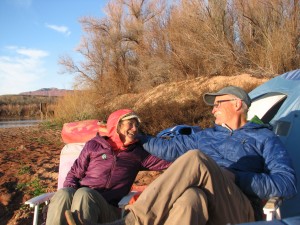
River Time (Utah)
“I try not to think about losing all our friends in Bozeman,” Marypat says. “It’s going to be really hard.”
“I know,” I agree. “And it’s going to be harder for you than me. I’ll miss our community, but I don’t thrive on my partners the way you do. I’m pretty capable of being a loner.”
Marypat sips her tea, sighs, looks off at the distant ranch lights, the dark wall of mountains behind. The river murmurs past.
“It’s a really weird time right now. But I’m trying hard to see it as an adventure, not a setback. And who knows, maybe we won’t really lose our community. Lots of our friends are retiring or cutting back, being more flexible about meeting for an outing. Most of them are making their own plans. Who knows where they’ll end up.”
“I know,” she says. “I’ll just miss calling someone up and spontaneously going for a hike. Or having people drop by.”
“That’s going to be tough,” I acknowledge. “But that will come with time, wherever we end up. And I’m not giving up on the Three Rivers tradition. Come Memorial Day, it’s going to happen again.”
The dangers presented along the Jefferson River are largely manmade. Natural hazards on moving water fall into predictable categories. Snags and logjams, which to my mind are the most treacherous features confronting paddlers. Ninety degree bends where the current runs smack into rock walls, known in the paddling vernacular as ‘wall shots’. And a variety of whitewater, most commonly caused by one of three conditions. Namely, a tight constriction of the river channel, water cascading over bedrock ledges, or rapids formed by tributaries carrying in loads of rocks during floods that clog the main channel with debris.
The Jefferson is free of most of those naturally occurring issues. Other than the odd snag or overhanging log, some tight corners, the river flows smoothly downhill at a heady rate but without much excitement.
Early the next morning, we edge up to the first major diversion dam along our route, just past a bridge on a ranch road. The river has been dammed by a wall of boulders set in place to check the flow enough to divert irrigation water into a ditch. Nothing natural about the rapid it creates. Normally I’d be looking for the ‘V’ to run down, or the eddies to pause in, or the route to ‘sneak’ along shore. Here there is a jagged barrier of boulders in a wall, with the river cascading through however it can. There is a hint of a ‘V’, or tongue of water, on river left. I remember the same slot when I ran it at flood stage. The dam was largely submerged at that water level, the passage more defined. I remember contemplating it, then running it, shipping a little water on the way through. This time the run isn’t as clean.
“No way, especially with Beans,” Marypat says, after a cursory look.
I’m more tempted than she is, but not enough to push back. It isn’t much of a carry, and we set about it. Beans limps across, we schlep the gear and the boat, set it in below the turbulence, repack, nest Beans in his spot. Maybe a twenty-minute chore.
The obstacles and hazards that present themselves here are bridge abutments, irrigation canals, diversion dams, sections of rough rip-rap channelizing the river, barbed wire draping in over undercut banks. I know how rivers respond to the environment. It isn’t always easy or predictable, to be sure, but the manmade challenges don’t conform to nature, they obstruct nature. They work to plug the flow, direct the flow, clutter or alter the way water wants to move. Farmers and ranchers don’t like the way a river channel erodes, meandering here and there, eating into property. Residents like riverside views, but don’t like floods, despite the natural functions floods perform. Road builders see a river blocking their path as a problem. As usual, we throw technology at the ‘problem’, try to assert our will over the natural force of moving water. In the long run, it’s a losing proposition, but we don’t think long-term. In the human worldview, a long time is a lifetime. In the world of rivers, a human life span is a grain of sand making its way to the sea.
But for those obstructions, the river is a joy. We cruise along, ticking off bends, miles, landmarks. I barely check the map. This is home ground. There are enough bridges, fishing access sites, or tributaries to keep track of our progress. Birds keep us entertained. A flock of natty, black-necked stilts pepper a gravel bar, looking like they are attired in tuxedos. They fly up in coordinated flocks, flashing in the sun, red legs trailing behind. Such simple, breath-taking beauty. Avocets bob and probe in the shallows. Yellow-headed blackbirds adorn a shrub like ornaments. Killdeer feign broken wings to distract us from their ground nests as we float past. Swallows scythe through the air. Bald eagles perch on cottonwood branches, waiting their chance to swoop on a trout. Marsh hawks tilt over the fields. We paddle past heron rookeries, messy nests of sticks congregated in cottonwood groves. Cinnamon teal, bluebirds, cormorants, sandhill cranes, bufflehead, pheasants, meadowlark. Our binoculars are in constant use. We keep pointing at new species.
Mid-afternoon, after a languid lunch stop and a siesta on a grassy bank, the second diversion dam of the day confronts us. We end up on the wrong side of the river. At flood stage I ran right through the turbulence before I even knew the diversion structure was there. At this level, more rocks protrude and the paths through are limited and littered with boulders. The best shot is along the far bank. Marypat is nervous about the whole thing. A portage would be arduous, up a steep dirt bank, around a concrete buttress, steeply down again through tangled brush. I lobby for a strategy that involves stroking back upstream along the bank, ‘ferrying’ the boat across above the dam, and then running the smoother option.
“I don’t know,” Marypat says. “The current is pretty strong. We don’t want to get swept into the dam.”
“I think we can do it,” I push.
In the end, it’s even easier than I thought. We stroke hard in the slow current along the near bank to get well above the rapid, angle the boat and paddle into the flow to make our way across, and then have an easy run down the left side.
“Yeah, baby!” I crow, in the fast water below.
“I don’t know why I get so nervous these days,” Marypat says. “I didn’t used to be that way.”
“You have a better knowledge of what can go wrong than you did in your bold and brave 30s,” I say. “And you weren’t part of the Social Security crowd back then either.”
Along these rivers, where civilization hovers over the banks, finding camps is akin to the daily challenge of the homeless, who seek temporary shelter where they can rest easy and avoid being hassled. After a few potential spots don’t pan out, we find refuge on a small island nestled under the river bank. There are some houses above and behind us, but we are out of sight below the high dirt bank. Across the river, in the distance, a grain elevator outside of the town of Whitehall and the mountain-top-removing scar of Golden Sunlight Mine. But here it is tucked away, intimate, sheltered. Our tent goes up. We collect firewood. The boat is turned over and secured to a bush. The only downside is that Beans finds a thicket of burrs that he gets coated with to the point that we have to cut them out of his fur with the wholly inadequate scissors on a Swiss Army knife.
Sunset casts the sky pink. A flock of white pelicans coast in and land on the river, their white breasts plowing softly into the current. They drift downstream in some shallows, then gather in a tight circle, begin agitating the water, corralling fish, gobbling them up with their pouched bills. The feeding frenzy lasts maybe a minute, then suddenly stops. The white birds float together downstream, like a serene fleet of dazzling ships in the last light of day.
This travel style is so reminiscent of our long trips across Canada. It feels more like lifestyle than recreation. We have our miles to make each day, the weather to adapt to, conditions to assess and navigate. It is stripped down and simple, while also profound and occupying. The chores of making camp, reading maps, cooking food, staying dry, traveling safely are both mundane and fundamental. The rest of life fades away. What comes into focus, then, is the immediate, the now, the essential. The world that we hold at arms length so much of the time comes flooding in, as real as the sharp stars and the ceaseless ripple of water.
I wake early in the morning to the sounds of a rousing world. Pale light. The liquid music of sluicing river. Some sandhill cranes call, close by. Robins are active. Canada geese honk and bark, like they have urgent business to attend to. I guess migration, mating, raising young is as urgent as it gets. I leave Marypat sleeping, start a fire on the fire pan, put water on to boil, feed in sticks. The thin plume of smoke trails downriver in the breeze. Maybe a tailwind today, I think. No rush.
Spring sun bathes the valley. I’m on my second cup of coffee when Marypat joins me, and it feels like mid-morning by the time we pack up and settle in the boat. Marypat is in the stern today. We switch positions each day to change things up, a habit we established powering a boat across the continent. It helps to appreciate the other paddler’s perspective and to change the view. In the bow you concentrate on close up adjustments, put in corrective strokes, have the world opening up before you. In the stern you take the longer view, establish the general line, and play off the body language of the bow paddler, who occupies the immediate horizon.
The wind gusts along, mostly behind us, so we scud downriver at as much as ten miles an hour, clipping past landmarks. A highway bridge abutment near the town of Cardwell sets up some squirrely eddy currents, strong enough to tip a boat if you aren’t ready for them. The Boulder River comes in, river left, then the South Boulder on the opposite bank. We enter the limestone canyon near Lewis and Clark Caverns, a spectacular rocky cleft full of pockets and caves and underground passages. It is scenic, but the river channels through in a straight, monotonous shot. I prefer the meanders, gravel bars, islands, every bend a surprise. This feels more like a slog. Not long after lunch we pull in and decide to camp on a flat bench. A quiet, two-lane highway ribbons next to the river across the way, but Marypat is keen to walk the abandoned electric railroad bed. We set up camp behind a berm that offers some privacy and protection from the wind, leave Beans on his bed, and strike off downstream on the old railroad grade, Marypat hunting for the porcelain insulators that once adorned the electric poles.
“Remember, we’re getting rid of stuff, not collecting more,” I caution, our burgeoning storage unit fresh in mind.
“Yeah, yeah,” she says, not the least swayed.
It is gray, spitting rain, the next morning when we load up. We wriggle into rain gear. The air is hushed and cool, the sky lidded. We don’t talk. Even the birds are quiet, huddled. Just paddle, eating miles, until the canyon releases us, we slide under a highway bridge, and approach the final diversion dam of the trip.
Fifty feet above the unnatural break in the river horizon we land and pull the boat up. A herd of cattle stand nearby, watching us. The river slides over the dam with an obvious tongue of water on river right. We stand above it, appraising.
“Portage?” Marypat says, hopefully.
“Nah,” I say. “Piece of cake.”
While we’re assessing the river, the cattle are assessing Beans, who is teetering in front of the aggressive bovine challengers.
“Hey!” I shout, jogging back, waving my arms. One steer is particularly confrontational, only reluctantly moves off as I run at him. No doubt these cattle have had their fill of herding dogs and see this as a chance for payback. The steer eyes us belligerently from twenty feet while we scoop Beans up and return him to the safety of the boat. The red canoe slides down the smooth ramp of silty water. The day clears. The river regains its meandering, island-dotted course. We stop for lunch, and to strip off layers, across from a limestone cliff with swallows arcing and gliding through the pushy currents of air.
The clearing day ushers in wind. Perhaps winds are what pushed the cloudy front off stage. They gather ferocity as we paddle on. Depending on the curve of river, we battle forward, or are shoved downstream, or skid sideways across the liquid surface. Willows bend before the gale. Spume lifts off of wave tops. We start looking for camp above the towns of Willow Creek and Three Forks.
As usual, there are a couple of dead ends that look promising from a distance, but won’t work, before we stumble on a brilliant beach on the lee side of an island, with a screen of aspen acting as a stunningly effective windbreak. All around us wind batters the vegetation, but on our beach it is completely protected. Protected enough to build a safe fire. It feels like the eye of a hurricane, unnatural stillness in the midst of maelstrom.
Not long after camp is set, the phone rings. “Guess we have service,” I say, overcoming my reluctance and looking at the phone. “Hey, it’s Grant Herman.”
“I’m about two hours west of Bozeman,” he says, when I answer. “Heading for Wisconsin and I thought I might stop in and bump elbows or something.”
“Dude!” I say. “We’re on the river. It’s my last month. You’ll be driving over the Jefferson on the interstate. We’re camped about a dozen river miles above the highway.”
“Windy as all hell,” he says.
“Tell me about it,” I agree. “Any chance you can lay over a day? We could be off the river by midday tomorrow.”
“Not this time,” he says. “Gotta tie up the last business in Wisconsin and get back home. It doesn’t seem like a great time to visit anyway. But I thought I’d at least check in.”
The intrusion of our outside lives interrupts the spell of river time. We both start thinking about the impending sale of our house, the resulting homelessness, the chores still to accomplish, the unpredictable news of the world. I make a fire, brew up hot drinks. A bald eagle parries the wind across the river, manages to land on a cottonwood branch. Sun pours over us like something we can wear. Slowly we return to our pocket of serenity in the windswept world.
And we resist the end the next morning. Marypat loves nothing better than to loll in bed until the sun hits with its delicious warmth. She luxuriates in that pool of light, snuggled in down, listening to the world outside. By the time she emerges, looking the way she looks after a gentle yoga class, I’m on my second or third cup of coffee, stirring the campfire, making notes in my journal, contemplating the day. My own version of campsite meditation. Not a bad duet.
Breakfast is relaxed. The winds have died down. Packing up is bittersweet. As are the final miles of river, sliding past the town of Three Forks, under a bridge or two, meandering briskly through the cottonwood bottomlands, avoiding a few snags, noticing herons and pelicans and hawks. The river is talking to us through the hull of boat, through the blades of our paddles, up our arms, into our torsos, into our subconscious.
The reel of all the rivers of this year scrolls across my mental stage. All those fluid relationships, from Grasshopper Creek to the Mountain River, from the ‘rises’ along the Suwannee in Florida to the hot springs dotting the lower Rio Grande. Friendships and brotherhood. Solo meanderings and good company. Strolling gravel bars for agates. Enduring the onslaught of thunderstorms. Watching a grizzly amble through camp. Riding the seasons of a yearly cycle like the currents of the rivers I chose. Rambling around the continent on this quixotic, lazy quest while most everything else on the larger stage is fraught with discord, tension, desperation, sickness, death.
We drift under the cool shadow of interstate highway, thinking of Grant, my November, San Juan River partner, who drove over the bridge less than a day earlier, glancing upstream toward our final camp. The Jefferson sweeps us along on her back, fast and implacable. We are together in this – the swirling currents, this trusted boat, my partner in life, our aging dog, my favorite paddle, this spring, bird-loud day.
The Madison River joins in from river right. The two waters, slightly different hues, mix and eddy together, blending personalities. A mile or two down, the Gallatin swings in from the east, dances its way onto the stage. The Missouri is born, suddenly burly with volume, rich with sediment, the first mile of its legendary journey across the span of continent. A pair of nesting peregrines call from the cliffs across the river, busy at the work of life.
AFTERWORD
For much of this year I felt the sharp contrast between my reality and that experienced by the majority of life on earth, human and otherwise. Never more than the last few months, with the heightened conflicts of unrest, death, disagreement. I inhabited my small, personal bubble, in which life was pretty fine, while, in the larger bubble all hell broke loose. This contrast was one I heard many people describe.
“I’m doing fine. Really well, as a matter of fact,” people would tell me. “But when I think about the big picture, it’s like an oppressive storm looming over me.”
In my bubble I’ve enjoyed good health, with fingers crossed. I have enough money in the bank. I have my family, my friends, and my community for support. I have good books to read, a partner to share my life with, and Montana to spend time in.
Yet, when I pan out, even just a bit, it all goes pretty quickly to hell. Our weather has been warmer and drier than usual, punctuated with some alarming episodes. In much of the world the weather is truly alarming, apocalyptic alarming, evacuate-now-alarming. Our politics have devolved to such an appalling level that we have to invent new terminology to describe it. Who would have thought, even after we elected Trump, that things would have gotten this crude, this cynically mendacious, this untethered from anything remotely normal. If this were a script being proposed to Hollywood editors, it would be laughed out of the boardroom as too far-fetched.
Millions of our brethren are falling through the cracks into desperation each day – financial ruin, emotional distress, life-threatening illness, food insecurity. In this existential state, events that would normally rise to the level of personal crises get overshadowed by the general emergency. A friend dies suddenly, unexpectedly, too young, but that event is overwhelmed by the larger context. A cancer diagnosis, a career lost, a marriage failed, all of it as fraught as ever for the individual, but lost in the cacophony we are mired in.
So I am left with this split-screen duality. I head out for an afternoon paddle on a local stream, or a hike on a mountain trail. I glide past groves of cottonwood on sparkling current, or walk through sun-dappled glades of aspen. I return home to my partner. We share dinner together, read books, maybe watch a show. While all around me, as wide as the view can get, things fall apart, someone dies of Covid every few seconds, politicians play games with people’s lives while they profit corruptly in plain view, and another storm/fire/flood hits somewhere in the world.
This contrast has always been so. Playing the comparison game is as old as humanity, and as unhelpful as ever. And yet, now, the juxtaposition is so staggering it makes me wonder if even those of us on the lucky end of the spectrum are just clinging to the driftwood of a shipwreck, relatively unscathed, but still adrift.
The only certainty is that time rolls on like the currents of the rivers I plied over the course of the year, tireless and immutable as ever.
In that march of time we did manage to sell our home in Bozeman two months after our final trip on the Jefferson River. We followed our realtor’s instructions, down to installing brighter light bulbs in some rooms. Suddenly the house was ready. A photo shoot happened, the For Sale sign went up in the yard, and we were told to leave town for a few days.
“When you get back we’ll look at offers,” the realtor said.
“Yeah right,” I thought.
Well, she was right. We had five offers in the first day, all above our asking price. We had to come home early from our camping weekend to begin processing. Within five days we were under contract, and before the end of the month, we were homeless, living out of our camper and availing ourselves of friends with flat driveways.
In that what-have-we-done fog, a realtor from Butte called in early July. “That house you were interested in that I told you was under contract just came back on the market,” she told us. “If you can be here tomorrow morning, you can look at it.”
We had planned to head for the Pryor Mountains in eastern Montana over the 4th of July. Instead we headed west, towing the trailer, planning to camp along the Skalkaho Highway in the Sapphire Mountains, and stopping in uptown Butte to get a house tour.
We toured. We made an offer. We left town.
Going camping seems to do the trick. By the time we regained cell service on Sunday, we had a text from our realtor. “You’re under contract,” she said. “Closing date is August 4th.”
For the month of July we parked in Marypat’s sister, Nancy’s, back yard. We made plans for projects in the new house – sheet rocking, floor finishing, stair building. We hiked in the Mission Mountains with friends. We drove south to Colorado to climb some 14,000’ peaks with family. Then, in early August, we closed the deal and officially moved to Butte America, Superfund capitol of the world, and also, a friendly, relaxed, unpretentious community full of stories and surrounded by new terrain to explore. The trade-off was the loss, or at least the attenuation, of the community we’d built for almost 40 years. A frontier. New eras. Another leap of faith in a pretty long string of leaps we’ve made together.
In that flow of time river trips have not stopped. We almost hit pause on the Three Rivers Memorial Day tradition in May of 2020. How could we keep safe and distanced within our camping and gathering tradition? Our friend Scott suggested that maybe we could do day trip outings on rivers close to home, and forgo the camping part. Someone else suggested doing bike shuttles to avoid being in cars together. So the tradition continued – three more quirky, seasonal Montana flows in the books. As much as it cemented our commitment to tradition, it was a chance to be with friends we dearly missed over the months of pandemic isolation. The enchantment of new water was overwhelmed by the joy of relaxed lunches shared on grassy river banks or sunny gravel bars, catching up with comrades.
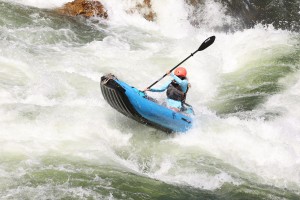
Marypat survives a big one!
Then, only partially moved in to our new home, with the wreckage of house improvements everywhere, we abandoned the projects and launched on the Middle Fork of the Salmon River on September 7th. Five of us, including Lee, Jeff and Molly, made good on our pledge to take on the entire through float from the headwaters of the Middle Fork, all the way down the Main Salmon, and into the Snake River, where we took out 23 days and 330 river miles later. We were joined by several friends for sections of the journey, which facilitated food resupplies and off-loading of poop buckets. For nearly a month we roared down one of the most iconic and inspiring drainages in North America, rollicking through the many boisterous rapids, camping on sand and gravel bars, taking whatever weather came our way, soaking in hot springs, singing around the fire, seeing birds, tolerating oppressive days filled with forest fire smoke, playing cribbage, telling our stories, settling deeply into River Time. 23 days and it ended too soon.
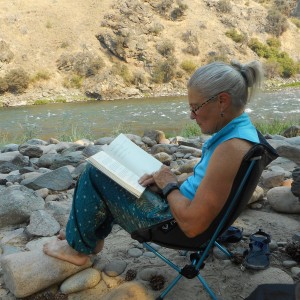
Marypat chillin’ on the Middle Fork of the Salmon.
I continue to be sober, ever since the family reunion after our Grande Ronde trip. Other than sampling some Christmas eggnog I have managed to resist those temptations, that pesky inner voice, those moments of weakness, and find the clarity that comes free of that numbing, ubiquitous influence. Of course, there are those moments, and those old impulses to give in. But honestly, it isn’t that hard, especially now, well over a year in.
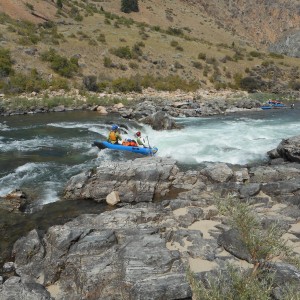
Running Tappan Falls on the Middle Fork.
I can’t say the same for my news compulsion. I was lulled a bit when Joe Biden won the election. I naively expected the noise to turn down, the craziness to abate, the political fever that had sickened our country to subside. There was a week or two in there where that seemed possible, and I tuned out the news. It was a relief to return to the boring, normal parade of reporting without the infusion of insanity. I started to have open books on my lap instead of the computer.
It didn’t last. Trump and his minions ratcheted up their false claims. Millions of Americans were watching a different movie, one full of fraud, outrageous lies, bizarre conspiracies and denial of the virus. And, not surprisingly, when stoked to a bonfire of outrage, those flames nearly consumed the country. I don’t know if any of those students I taught during the 2016 election, the kids I admonished to ‘pay attention’ were watching, but I was.
What comes next is anyone’s guess. Marypat and I in Montana are embarking on a new chapter in our lives. We still hunger to vagabond around the countryside. Next Memorial Day the Three Rivers will feature water in our new neighborhood. The vaccine is coming our way. Some version of safety and normalcy is dimly in sight. But we have no idea what normal will be anymore. Our country is also forging a path through the wilderness of truth and fiction, loyalty, resolve, danger. I have been a little embarrassed by what seems like hyperbole, but over this year I have come to see the drama playing out as a titanic battle of good vs. evil. Right now, it seems less hyperbole and more apt description.
So we are paused, all of us, as if above a heart-pounding rapid on a river. We have parked the boats upstream and are walking down to scout the passage through the turmoil. We stand together, sober and focused, discussing the line. Several of us wander off to pee out of anxiety. We point out options, voice opinions, weigh dangers, come to some semblance of agreement, and start back to our boats, earnestly talking with our partners about what needs to happen, what to watch for, and how to react if things go badly wrong.
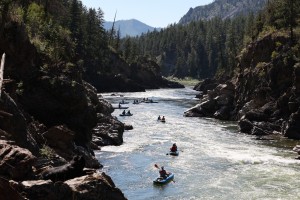
Some of our cherished river pals in Alberton Gorge on the Clark Fork River in Montana.

